Kimchi is one of those things that seems so exotic but is so ridiculously easy to make at home — and fresh, homemade kimchi is infinitely better tasting than anything you can buy from the market.
If you’ve never had this fermented side dish, think of it like a spicy Korean version of sauerkraut. The smoke and fire comes from gochugaru, a Korean red pepper powder (sometimes also called Korean chile flakes or Korean chili powder, but definitely not to be confused with American red pepper flakes or American chili powder).
Homemade kimchi is a pungent and complex blend of flavors owing to traditional spices (gochugaru, garlic and ginger) as well as a puree of Asian pear and yellow onion, which adds a subtle sweetness without the need for sugar. I use red cabbage for the same antioxidant benefits I get from my ruby kraut. (But you can also use the more traditional napa cabbage.)
Similar to kraut, kimchi is full of probiotic goodness and it’s not solely limited to Korean dishes. I’ve made kimchi omelets, kimchi quesadillas, kimchi pizza, and even spooned a heaping of kimchi on a baked potato. This version is a medium spicy that won’t burn your tongue off, but still has enough heat and tang to make a meal interesting.
Red Cabbage Kimchi
Makes 3 quarts
Ingredients
2 pounds red cabbage, chopped
1/4 cup pickling salt
1/2 pound daikon, julienned
1/2 pound carrot, julienned
6 green onions, sliced into 1-inch segments
4 cloves garlic, minced
1-inch piece fresh ginger, peeled and minced
1 small Asian pear (or apple), peeled, cored and chopped
1 small yellow onion, chopped
1 cup dechlorinated water
1/2 cup gochugaru (Korean red pepper powder)
2 tablespoons fish sauce
Making Your Red Cabbage Kimchi
Red cabbage tends to be a tad tougher than napa cabbage, so I chop mine into thin, bite-sized pieces.
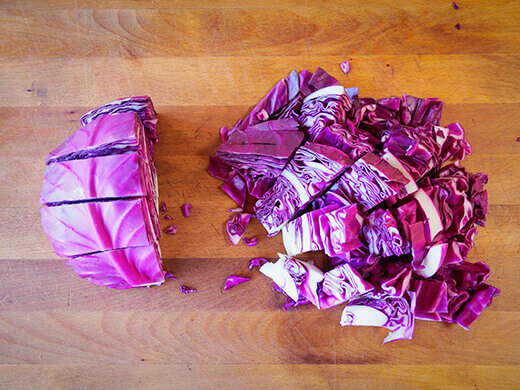
In a very large bowl, massage the salt into the cabbage until the leaves start to release liquid.
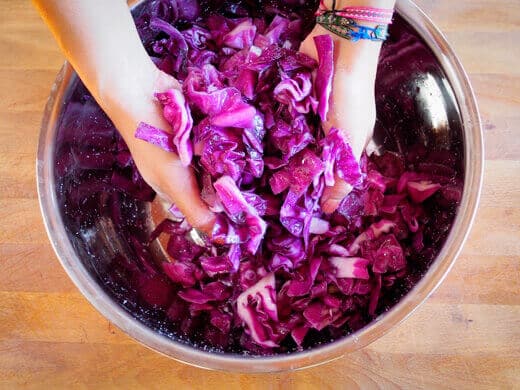
Cover with water and let the cabbage sit at room temperature for at least two hours while the salt draws out moisture. Periodically toss the cabbage and work your hands through the leaves to expel more moisture.
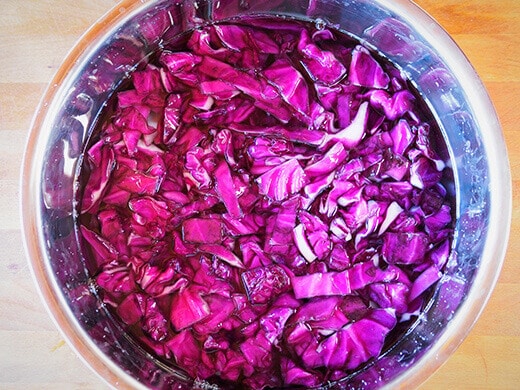
After about two hours, the cabbage should be soft and limp, and the volume reduced in half. (If yours is still firm and full, come back to it after another hour or two.)
Strain the cabbage and rinse under running water to remove excess salt.
Strain again, then return the cabbage to the bowl. Add daikon, carrot, green onions, garlic, and ginger.
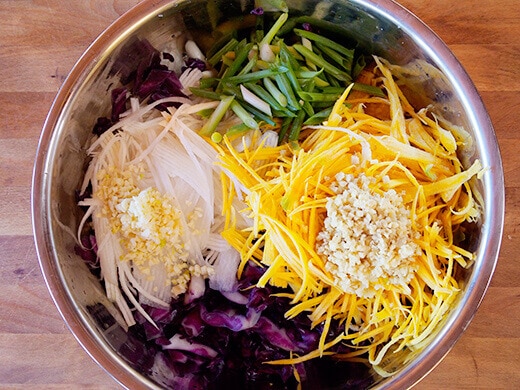
In a blender, combine the Asian pear (or apple, if using), yellow onion, water, gochugaru, and fish sauce, and give everything a whirl until smooth. Pour the sauce over the vegetables.
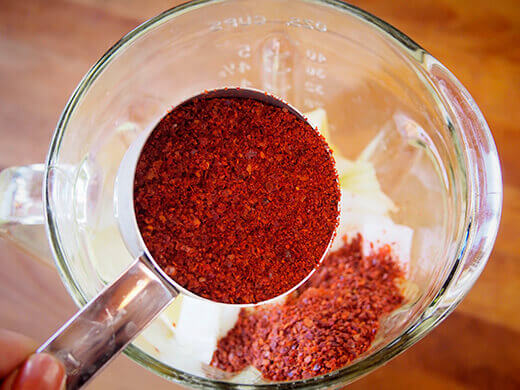
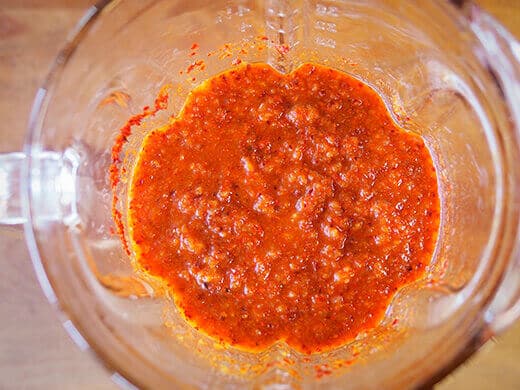
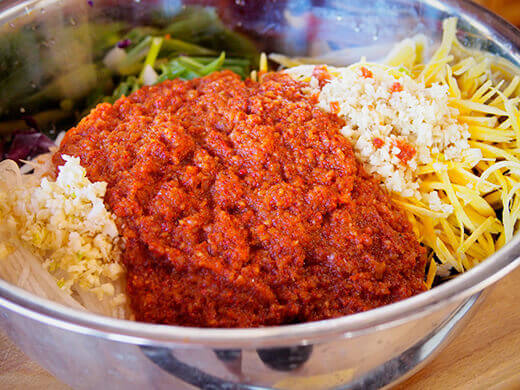
Now, don some gloves (the sauce can be pretty spicy and smelly to work with!) and give the kimchi a good rubdown, making sure the veggies are well combined and coated with sauce.

Pack the kimchi into jars, leaving 1 to 2 inches of headspace. The veggies will expand and release more liquid as they ferment, so you don’t want to overfill the jars.
Tamp down the veggies with the back of a spoon to fully submerge them. I find that there’s always enough liquid in the jars to keep them submerged, and since the liquid is more of a paste, the veggies don’t float to the top as in other ferments.
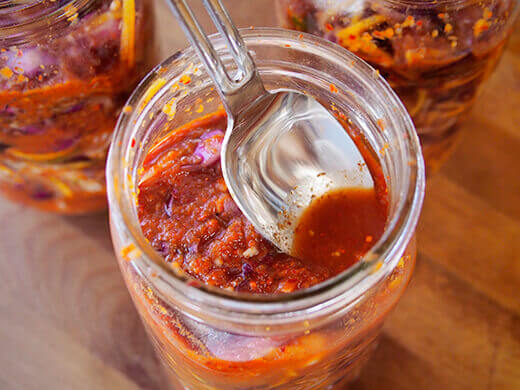
Wipe the rims clean, then loosely seal with lids and let the jars ferment at room temperature, out of direct sunlight, for at least three days. (It wouldn’t be a bad idea to place the jars in a shallow baking dish to catch any overflow of liquid.)
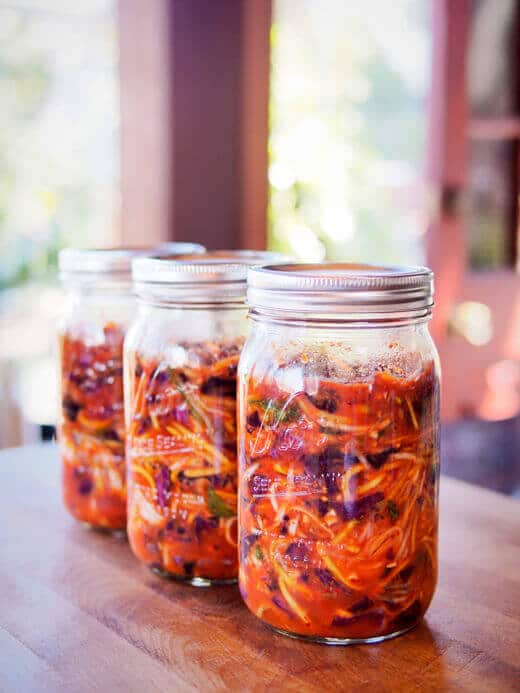
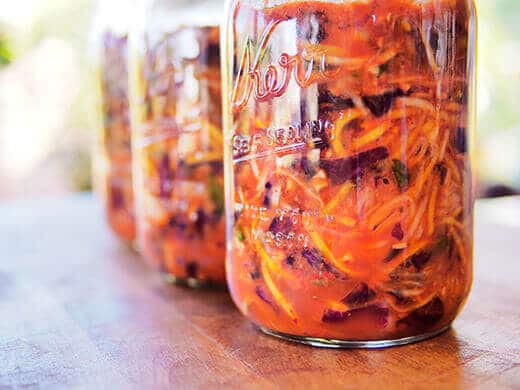
Every day, press down on the veggies with a spoon to expel more liquid and make sure everything is shipshape. A proper ferment should have no mold and no off smell.
After three days, you can start tasting the kimchi; refrigerate when the flavor has fermented to your liking. It should take on a spicy, sour taste. Some people like less sour and some like more sour, but you should definitely wait for your kimchi to take on a noticeably tangy taste if you want all the beneficial Lactobacilli in your ferment. I like to let mine brew for up to a week at room temperature for a more intense flavor.
Don’t worry if you feel that 3 quarts is too much kimchi for you to handle — let one of the jars get too sour in the fridge, and next month I’ll share one of my favorite Korean comfort food recipes that uses overly fermented kimchi!
Red Cabbage Kimchi
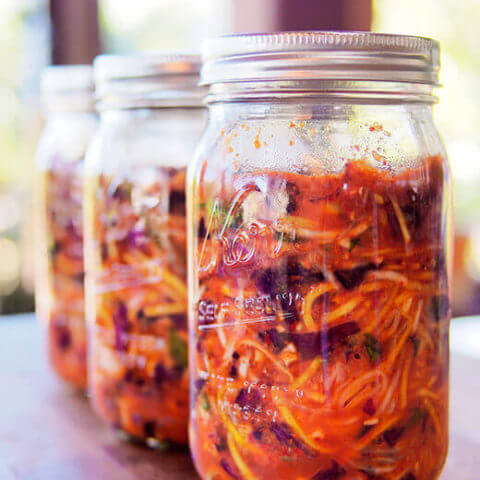
Homemade kimchi is a pungent and complex blend of flavors owing to traditional spices (gochugaru, garlic and ginger) as well as a puree of Asian pear and yellow onion, which adds a subtle sweetness without the need for sugar.
Ingredients
- 2 pounds red cabbage, chopped
- 1/4 cup pickling salt
- 1/2 pound daikon, julienned
- 1/2 pound carrot, julienned
- 6 green onions, sliced into 1-inch segments
- 4 cloves garlic, minced
- 1-inch piece fresh ginger, peeled and minced
- 1 small Asian pear (or apple), peeled, cored and chopped
- 1 small yellow onion, chopped
- 1 cup dechlorinated water
- 1/2 cup gochugaru (Korean red pepper powder)
- 2 tablespoons fish sauce
Instructions
- Chop Cabbage
In a very large bowl, massage the salt into the cabbage until the leaves start to release liquid.
Cover with water and let the cabbage sit at room temperature for at least two hours while the salt draws out moisture.
Periodically toss the cabbage and work your hands through the leaves to expel more moisture.
After about two hours, the cabbage should be soft and limp, and the volume reduced in half. (If yours is still firm and full, come back to it after another hour or two.)
Strain the cabbage and rinse under running water to remove excess salt.
Strain again, then return the cabbage to the bowl. Add daikon, carrot, green onions, garlic, and ginger.
In a blender, combine the Asian pear (or apple, if using), yellow onion, water, gochugaru, and fish sauce, and give everything a whirl until smooth. Pour the sauce over the vegetables.
Now, don some gloves (the sauce can be pretty spicy and smelly to work with!) and give the kimchi a good rubdown, making sure the veggies are well combined and coated with sauce.
Pack the kimchi into jars, leaving 1 to 2 inches of headspace. The veggies will expand and release more liquid as they ferment, so you don’t want to overfill the jars.
Tamp down the veggies with the back of a spoon to fully submerge them. I find that there’s always enough liquid in the jars to keep them submerged, and since the liquid is more of a paste, the veggies don’t float to the top as in other ferments.
Wipe the rims clean, then loosely seal with lids and let the jars ferment at room temperature, out of direct sunlight, for at least three days. (It wouldn’t be a bad idea to place the jars in a shallow baking dish to catch any overflow of liquid.)
Every day, press down on the veggies with a spoon to expel more liquid and make sure everything is shipshape. A proper ferment should have no mold and no off smell.
After three days, you can start tasting the kimchi; refrigerate when the flavor has fermented to your liking. It should take on a spicy, sour taste
Notes
Red cabbage tends to be a tad tougher than napa cabbage, so I chop mine into thin, bite-sized pieces. Don’t worry if you feel that 3 quarts is too much kimchi for you to handle — let one of the jars get too sour in the fridge.
Recommended Products
As an Amazon Associate and member of other affiliate programs, I earn from qualifying purchases.
-
Ball Mason 32 oz Wide Mouth Jars with Lids and Bands, Set of 12 Jars.
-
Organic Bamboo Cutting Board Set of 3 with Lifetime Replacements - Wood Cutting Board Set with Juice Groove - Wooden Chopping board Set for Kitchen, Meat and Cheese - Wooden Cutting Boards for Kitchen
-
ZWILLING Pro 7-inch Rocking Santoku Knife, 7'', Black/Stainless Steel
View the Web Story on red cabbage kimchi recipe.


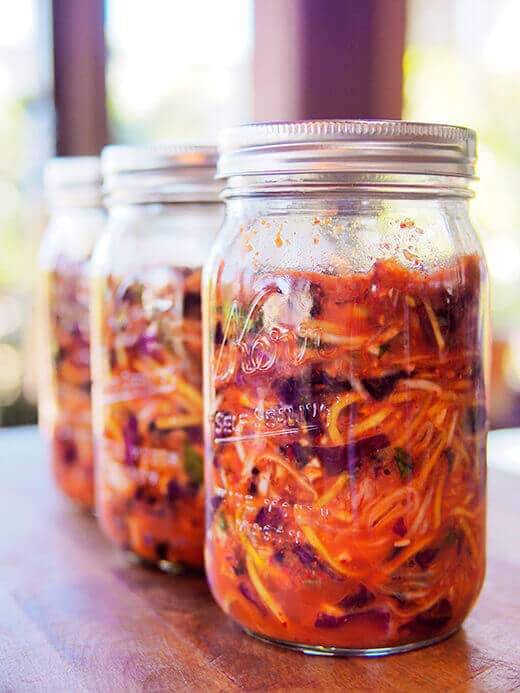
















Thank you for the recipe. I am just wondering if there should not be added salt whwn all the ingredients are mixed together after salting and rinsing the cabbage?
Best regards,
Morten
Hi Garden Betty. Can I use frozen cabbage for kimchi? I harvested all of my cabbage last year and still have some in the freezer?
Tania
I haven’t tried it, but I’d assume frozen cabbage (after being thawed and drained) would still have some of the sugars that make fermenting possible. The process might take a little longer, so if you have some fresh cabbage or fermenting liquid left over from another jar, try putting some of that in with the thawed cabbage.
Thank you for your reply. Finally I decided to use fresh fava beans because we had kilos and kilos of them. Instead of using the Korean red pepper powder I used my own fresh chillis. So my beans don’t have the lovely red pastey look of the Korean kimchi.
I have a question. My fava beans have been sitting in jars now for 48 hours and there is a thick paste sitting at the top. Is that bad? Should I remove it ir is it normal?
Thanks,
Tania
Would it be okay to leave out the fish sauce? 🙂
Thank you for the kimchi recipe. It turned out so yummy! For my first attempt at kimchi, the result is very good and I know I will be making it again soon. Perfect amount of spicyness and flavour!
Thank you! So glad you like it!
Well, I tried your recipe this week 🙂 using my garden Napa cabbage and garlic. My radishes weren’t ready yet but I found them at the grocery. I sort of goofed because I added the chopped apple to the bowl instead of the blender (!!), but I’m sure it didn’t really upset recipe too much. After three days I took a bite and it was really good. I can’t wait to try it next year with red cabbage and maybe a pear instead of an apple. I sure hope hubby likes it since I doubled the batch and have several jars.
My only real problem is that I got the bright idea to turn the jars upside down after 3 days so that the veggies on top got more liquid since mine was a bit less fluid. Well, even though I tightened the lids, the liquid oozed out on my countertop. Darn mason jars!
I’m so glad you enjoyed the recipe! Pear is great in it too.
Oops, I meant to spell it Gochujang!!
Hello! I have a prepared Korean chili sauce called Gocgujang, would this be an ok sub for the chili powder (certainly not in the same portion as the powder) and if so any suggestions on how much?
Thank you for your reply!
Elena
Wisconsin
Yes, you can use gochujang (pepper paste) in place of gochugaru (pepper powder) but your kimchi will probably have a slightly sweeter, earthier flavor. I’ve never tried it so I don’t really know the proper amount to use; maybe start with half (the amount of gochugaru called for) and add more to taste. Personally, I’d add one or two fresh red chile peppers as well, unless you prefer your kimchi on the mild side.
I made this recipe and I did not have enough liquid to cover the veggies so I use some of the left over water from when i soaked the cabbage in distilled water. How will that affect the flavor? I noticed after the fact that you suggested to make more gonchugara sauce in another conversation if there is not enough liquid.
The extra cabbage liquid should be fine, assuming you only added a small amount to submerge the vegetables. You may find that after a few days, the cabbage starts to expel more liquid of its own as it ferments as well.
I just made this recipe and I decided to taste my kimchi.
It tastes kind of “fizzy.” It tastes like I’m eating “kimchi soda.” Did I do something wrong? I mean, It made 3 jars. I’m kind of nervous about it. Other than that it tastes good.
It’s natural to see bubbles while your kimchi is fermenting. If it tastes good, it’s probably ready and can be refrigerated (at which point the fermentation process will slow down considerably).
I meant that when I chew it, it tastes a little fizzy. Kind of like I’m eating cabbage using the same stuff they use to make pop rocks “fizz and pop” in one’s mouth. Is that normal? I worked so hard and I don’t want to end up throwing it away T_T
I’ve never had kimchi taste fizzy, but if it looks, smells, and tastes fine, it’s probably nothing to worry about.
It makes me think of the fine fizzy bubbles in champagne. I love kimchi!
I know the premise of this recipe is based around red cabbage but I was wondering if one could use green cabbage as well.
Where I live it’s pretty hard to get red cabbage without paying an arm and a leg. I’m in college and money is kind of tight.
The recipe looks amazing and I bet it tastes even better.
Absolutely! You can use napa cabbage or regular green cabbage instead.
So excited to find this recipe as I have several heads of red cabbage left in my garden…. I’ve never made Kim chi before, so thanks for the good instructions, but can I use a different spice? I live in a small town in Vt with no Korean grocery near by…. I’m sure I could find it on line, but I need to make it soon before the frost kills my cabbage.
If by spice, you mean a substitute for the gochugaru, you certainly can… but it would take on a totally different flavor. It isn’t necessarily bad, but if you know what traditional red kimchi should taste like, using a different spice could yield a surprising result. You would also need to experiment with the proportions of the spice(s) you choose, as using a full 1/2 cup of something else could make the kimchi much too spicy/smoky/etc. I recommend buying gochugaru online from Amazon, or from a Korean grocer like hmart.com.
Hi, I made as instructed but there was very little liquid in which to submerge the vegetables fully. Now on their second day the liquid is still about half way up the jars, even after I press the veggies down hard. Does this mean I am inviting bacteria in a bad way, and that if the veggies aren’t IN the liquid, the whole batch is a loss?
Leaving the vegetables exposed will cause them to eventually mold on the surface, so I recommend making a little more of the gochugaru sauce to add to your jars.
Bless you, bless you and bless you! I just tasted mine after three days of fermenting. It’s more than bloody fantastic. I was out of Korean radish (my roommate used the last of it w/o my knowledge) and so I ended up upping my carrot quantity.
I added some blended habanero peppers to it since that’s the spice level that I grew up with and enjoy, so that’s another little tweak I did to your wonderful recipe.
It’s spicy, pungent, not overly sour and the flavors intertwine just perfectly plus it is absolutely beautiful to look at.
Thank you for this recipe. I now need to figure out how to hoard this all to myself 😀
I’m so happy it turned out well for you! Enjoy!!
Wonderful!
Thank you for posting your delicious recipe. I made this about three days ago. I had to make some modifications because I did not have time to go to my local Asian market to see if they had the daikon or red pepper powder. It turned such a beautiful purple red color and smells absolutely delicious. I can’t wait to eat it. Thanks you again!
You’re welcome!